Welcome to the age of cloud computing where business agility, scalability, efficiencies and cost savings are considered among the top benefits. Inceasingly more companies are migrating and building mission-critical applications for the cloud environment. Perhaps more than any industry, healthcare is found with endless opportunities to get interactions right.
In simple words, the term cloud computing is defined as delivering computing services such as servers, storage, databases, networking, software, analytics and many more over the cloud (the internet). This ensures quicker innovations with the use of malleable resources for the faster boost in economic sales. In addition to this, it successfully helps in cutting down the costs while managing a smooth service-based infrastructure as your business needs.
Considered as a major boon to the conventional business ways, cloud computing has passed over even ordinary digital technologies. As a result, SMB’s to fortune 500 companies are looking forward to adopt the learning curve. Further below I would like to mention how it has an astonishing impact on other industries such as Automotive, Education, Financial, Healthcare, Insurance, Hospitality, Real Estate and many more on the run.
- Affordable Costs
Cloud Computing estimates to cut down the capital expense of buying hardware and software, setting up the servers, and loads of database along with the storage accommodation for tons of networking. It adds up faster.
- Galloping Speed
Most of the Cloud Computing services are provided on demand and handled with self-serve. This ensures that the vast services are provided quickly within minutes on the click of a mouse by providing the businesses flexibility and more capacity.
- High Productivity
The on-site racks of database and network storage pressure with the number of people required to manage the system create a chaotic situation for any organization. With Cloud computing, it helps to prevent such identified problems and increases productivity.
- Boosts Performance
Cloud computing services run on a worldwide network of secure data centers, which are regularly upgraded for faster and efficient computing hardware. This offers several benefits over a central data center, including reduced network structuring pattern for applications and greater economies of scale.
- Hand-over reliable Security
Cloud providers offer a broad set of policies, technologies, and controls that strengthen your security pattern overall, helping protect your data, apps, and infrastructure from defined threats.
- Global Scale
The benefits of these services include the ability to scale elastically and delivering the right amount of IT resources. For example, more or less computing power, storage, right bandwidth when it is needed and from the exact geographic location.
Impact of Cloud Computing in Healthcare
Businesses in numerous industries have made the move to the cloud, while others still hold onto traditional ways referring to security concerns. These concerns are especially crucial in the healthcare industry, due to its sensitive, private patient data. As cloud security strengthens, healthcare can finally take advantage of the efficiency and cost savings of the services provided by the cloud.
There is substantial growth in demand for healthcare services because of severe populations, an increase in chronic diseases and comorbidities. Expectations for better outcomes, high-quality treatment, and more benefits from the healthcare services provided increase the need for point-of-care access to medical data and the parallel evolution by the adoption of mobile devices, both for medical staff and for patients, are forcing the need for IT systems to adapt.
Also, the significant increase in digitization of medical records including the accelerated increase in adoption of electronic medical records (EMR), electronic health records (EHR) and personal health records (PHR) along with the increasing prevalence of digital outputs from scanning and monitoring devices, such as magnetic resonance imaging (MRI) scanners and bedside monitors and infusers, provide more accurate and varied digital data to maximize the potential benefit from cloud solutions.
The economic benefits of cloud computing can be significant since cloud computing provides the services at affordable costs and the potential to reduce costs. Heavy capital expenditure can be avoided because IT resources are acquired on mouse clicks as needed and paid for as an operating expense.
Also, the cost of staff resources required to deploy and maintain IT resources are reduced or expelled by the cloud computing. Therefore, the need for additional healthcare provider skilled IT staff resources and related costs may be reduced when using cloud services for SaaS solutions where the cloud service provider takes the main share of responsibility.
Today, there is already many and varied cloud service available for healthcare, covering a wide range of capabilities. The benefited services which are provided by the cloud is as described.
For Healthcare Professionals
A workday in this industry is very hectic, but with the cloud, it can streamline business operations through accessibility and cloud-based clinical applications.
- Care Management Support
Hospitals and physicians are more and more utilizing cloud-based practice management, medical records, and medical image for better solutions. These solutions provide cost-effective implementations unlading tasks from hospital IT departments allowing them to focus on supporting other operational and clinical support systems. Some of the existing tools in the marketplace today:
IBM Waston Care Manager
It helps organizations unlock and integrate the full breadth of information from multiple systems and care providers, automate care management workflows, and scale to meet the demands of growing populations under management. The care plans are individualized and recommend the optimal combination of structured programs, best practices, and personalized insights.
Watson Care Manager is built on an innovative HIPAA-enabled and cloud-based platform that can aggregate data and connect stakeholders, helping to support the coordination and delivery of services.
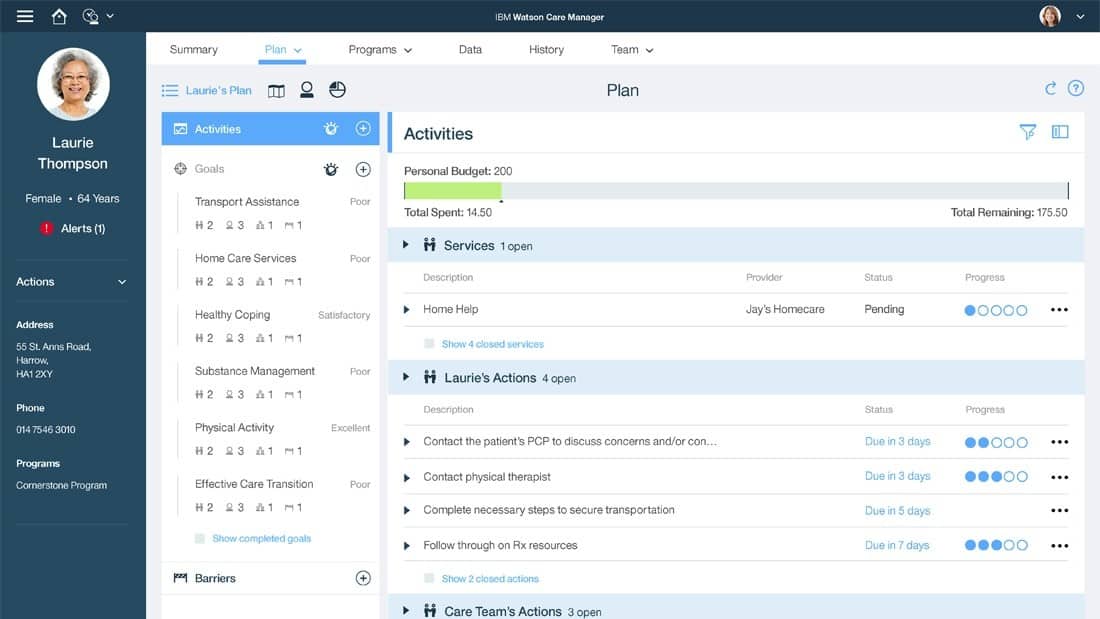
Image Source: IBM
Care Manager Workspace
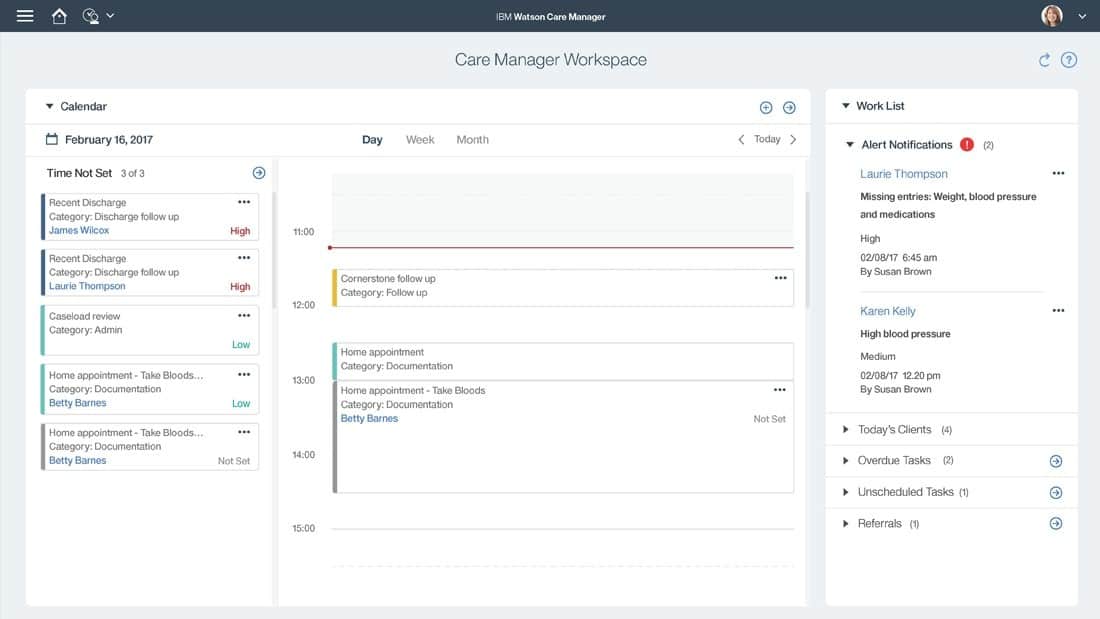
Image Source: IBM
Supervisor Workspace
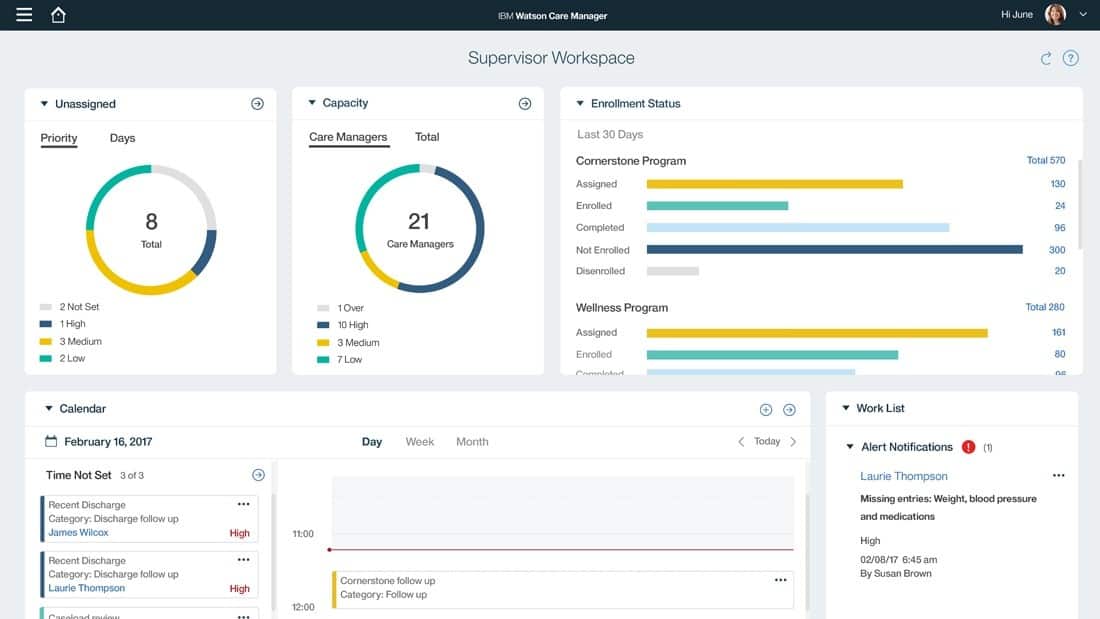
Image Source: IBM
Physician Group Management Services
Physician Group Management Services is developed for independent physicians and hospital-employed physicians who want to improve efficiency and earn revenue at the medical practice while improving the overall experience. It reduces administrative burden with practice management services. Improves the cost control and maintaining efficiency. It also satisfies the physician by supporting quality patient care with sound financial management. Also, it helps to strengthen medical practice performance with profitability analysis to drive revenue and improve patient care in the shift from volume to value.
- EyeArt
It combines automated image analysis tools with a user-friendly telemedicine or cloud-based interface to address the need for faster screening of more diabetic patients, and also provide the best professional with high confidence in finding the right patients. With evidence on the patients, it has been shown to have higher sensitivity at identifying referable DR patients than found with human grading, while in accordance with internationally recognized standards, such as International Clinical Diabetic Retinopathy (ICDR) severity scale which is sponsored by the American Academy of Ophthalmology (AAO). The technology allows all DR screening to be performed in the office, in a single visit, without the inconvenience of sending images outside the office for grading.
Images from diabetic patients are extremely inconsistent in quality, and automated screening systems often exclude many of these images from the analysis. EyeArt has been studied in large-scale, real-world settings using images captured in everyday practice, demonstrating the ability to work effectively with images of varying quality. EyeArt’s flexibility also allows its use with standard imaging protocols used in eye-care practices.

Image Source: EyenUK
- RxEye Cloud
Nowadays, sharing or collaborating with others around patient images doesn’t have to be time-consuming and costly. In fact, it is easy and simple whether you need to share information with someone on a single occasion or want to collaborate more tightly with patients. One can efficiently and securely share and collaborate around all types of medical images, including digital pathology cases with no more need to produce and send CDs, USB drives, or paper copies.
Firstly, RxEye Cloud collects the information in your local system, or access and view it online from anywhere ideal when the patient has been transferred, or for multidisciplinary team meetings with participants from different and geographically spread organizations.
- MIG
It is the interoperability specialist and connects different healthcare software systems to support faster more effective care. Healthcare Gateway implemented the Medical Interoperability Gateway (MIG). It provides various services including the detailed care record for tracking the patient’s health record, document services which enable to share the reports to another hospital, marketing communications package, service discovery locator to check the exact location, shared record viewer to discuss on the patient’s situations, and specialist datasets.
- Medidata Clinical Cloud
It supports diagnostics and medical device as well as clinical rails. Engages the patient through Rave Patient Cloud. Optimized edge study to improve the operational execution. Rave imaging enable to capture the photos and helps to detect the critical situation. The patient profile provides a patient level data chronologically aligned with the visit dates while setting the conditions to get flashed about the important patients and events. Medidata enroll provides for complete patient care to improve the clinical trial.
For Patients
The cloud allows easier access between other healthcare professionals and organizations. Patient data and test results can be easily shared with a different healthcare provider that might need it. This not only saves the time of the professionals but also on the patient side. Cloud savings will trickle down to patients, who won’t have to double pay to have the same test done twice when they need to see different doctors or lose the paper copy. This has an immediate impact on the patient experience and is a step on the correct path.
● Oncology and treatment planning system
It is built to meet the technology needs of the people of the community practice of the future with operationally efficient and prepared to thrive in the world of value-based care. Flatiron is chosen by 2,500 clinicians at more than 800 sites across the country as their long-term technology partner. Many clinics face difficulties in reality such as declining reimbursement rates, increased patient loads and regulatory changes. Many people find it financially challenging to remain financially viable while delivering the best care possible. Flatiron’s OncoCloud products can help diagnose cancer and tumors. The treatment of this diseases is made possible by the deep research in this field.
- Cerner
Diagnostic decisions up to 80% are informed by lab test results. To reduce manual steps in the lab workflow, specially designed by Cerner, for making information easier to share. Everyday lab problems are solved by offering unique solutions by the Cerner laboratory team. Cerner innovations, such as Radio Frequency Identification (RFID) tracking, are designed and designed to help with the clinician’s positive identification tasks, along with the laboratory and health system workflow.
- MediaLab
It is the cloud-based solutions for clinical laboratories. More than 2,500 laboratories throughout the US and Canada trust MediaLab with their document control, inspection readiness, compliance education, and CE requirements.It provides variant facilities like Compliance & CE, Histology CE, Document Control, Inspection Proof, Personnel Documentation, WBC Differential Simulator, Advanced WBC Differential Simulator, RBC Morphology Case Simulator.
- Prescription drug monitoring program
Physicians in many states are required to check their state’s Prescription Drug Monitoring Program (PDMP) database as a safeguard against the diversion and abuse of prescription medications, before prescribing drugs to their patients. Most include a broad range of narcotics, tranquilizers, and stimulants but the rules vary from state to state, as well as which medications are covered by such program.
Until now, however, there has been no easy way for prescribing physicians to check these records from other states, making for a time-consuming process that may have to be delegated to someone else. This leads to taking up staff’s time and taking away valuable time spent with patients.
Project Manager Deborah Wade and others at eClinicalWorks, in association with Appriss Health, are building a Prescription Drug Monitoring Program (PDMP) integration. The result? Database checks between states will be as easy as clicking a button – leading to better and safer medicine nationwide.
- Eva
Eva is the most innovative featured eClinicalWorks Virtual Assistant. Just as online experiences for consumers and those surfing the Internet is setting out by well-known virtual assistants such as Amazon Alexa and Apple’s Siri, Eva is setting out to make the physician’s experience simpler and faster. Let’s take a closer look at what Eva can do.
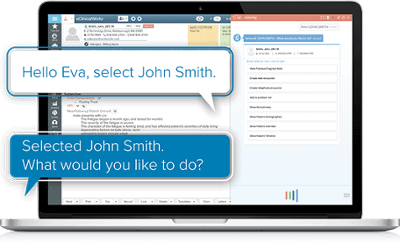
Image Source: Eclinicalworks
In the healthcare industry, Eva is the first embedded virtual assistant, which helps providers, saves time by eliminating clicks and increasing efficiency. Electronic Health Records have now largely displaced paper charts at most practices nationwide, still, they come with their own set of challenges. Recent research by Stanford Medicine and The Harris Poll finds that while about two-thirds of physicians are generally satisfied with their EHR, 59% believe EHRs nonetheless need a complete overhaul.
- HIV care
Researches have researched for a long time to mutation ability of HIV. It directly targets the body’s immune system which should probably remain very strong to fight off any disease. HIV conquers more of the immune system in the body. Chattanoga cares is set on the cloud computing purpose for the especially HIV patients. It helps them to get out of the chronic situations and also motivates to lead a healthier life with the regular doctor visits and regular medicines.
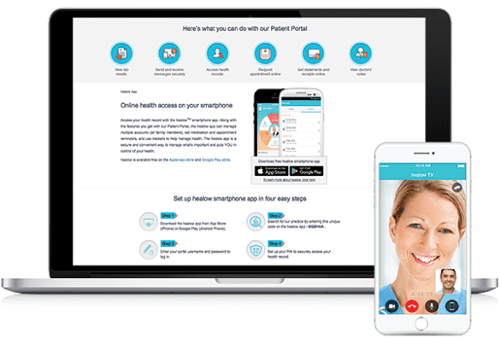
Image Source: Eclinicalworks
- Opiod
In an effort to ensure that opioids are prescribed more appropriately, the CDC developed and published the CDC Guideline for Prescribing Opioids for Chronic Pain. The guideline covers:
1. Ensuring proper dosing, duration, follow-up, and discontinuation of opioids
2. Use of risk-assessment instruments
EHR companies share responsibility for developing solutions to help combat the opioid abuse epidemic. Solutions must limit the number of pills in circulation and lead to progress in providing better and safer medicine across the nation.
One part of the solution being developed by eClinicalWorks is the Opioid Risk Tool (ORT), a smart form to assess and address a patient’s risk for opioid misuse and to improve physician adherence to treatment protocols. Properly used, the tool can help increase the safety of controlled substance prescriptions, while preventing and detecting opioid misuse and abuse.
eClinicalWorks also supports Electronic Prescribing of Controlled Substances (EPCS), and in association with Appriss Health, eClinicalWorks has built a Prescription Drug Monitoring Program (PDMP) integration that allows physicians to access state databases at the point of care. The partnership automatically integrates into the EHR, streamlining PDMP data access for providers, and offering a solution to combat drug misuse. Currently, many states are integrated with PDMP and the providers have already taken steps to manage improper prescribing and dispensing for controlled substances.
HIPAA and the cloud
The Health Insurance Portability and Accountability Act (HIPAA) is intended to improve the efficiency and effectiveness of the health care system. Adoption of national standards is required for electronic health care transactions and code sets, as well as unique health identifiers for providers, health insurance plans and employers. The law recognizes that electronic technology could erode the privacy of health information and incorporates provisions for guarding the security and privacy of personal health information. It enforces national standards to protect individually identifiable health information (known as the Privacy Rule) and the confidentiality, integrity, and availability of electronic protected health information (known as the Security Rule).
Guidance for Leveraging Cloud Computing in Healthcare
This section provides a prescriptive series of steps that should be taken by cloud service customers to ensure successful deployment of cloud-based healthcare solutions. The following steps are discussed in detail:
- Build a business case for cloud computing
- Identify and prioritize specific cloud-based healthcare solutions
- Determine the appropriate cloud deployment and service models
- Ensure all security and privacy requirements are addressed
- Integrate with existing enterprise systems
- Negotiate cloud service agreements and monitor key performance indicators
- Manage the cloud environment
Bottom-Line
We saw the huge benefits one could get from Cloud Computing. From gathering electronic records, streamlined collaboration, data storage capability, advanced clinical research to the telemedicine capabilities, Cloud Computing can be predicted to be the Next Gen mechanism. A lot of people over the world can gain benefit from it and by saving a storage server, one can instantiate the leftover for another purpose. It offers significant benefits to the healthcare industry where quick access to large data and reports are preserved. Cloud caters all these requirements and thus provides the healthcare industry an opportunity to improve overall experience to their patients by saving time and working efficiently. Thus, in the end, we also need to look at the future use of the increasing Cloud services to reduce space and time complexity. Have your hospital started to utilize the potential of Cloud Computing yet?
from Health Care Technology – ReferralMD https://ift.tt/2Ap5sEJ
via IFTTT

No comments: